
Table of Contents
As the Mid-Autumn Festival approaches, traditional Cantonese mooncakes make their annual appearance. Artfully molded pastries filled with a sweet nut or bean based filling, these beautiful pastries are a must-have for gifting to friends and family and creating a festive mood. These days you can fairly easily find mooncakes in Chinatown and at large Asian markets. But nothing beats the homemade type, which tastes way more fragrant and is not super sweet.
The most common mooncake fillings are lotus seed paste filling and red bean paste filling. But in this post, I want to share my favorite mooncake flavor – black sesame filling. Compared to the other fillings, this one is nuttier, softer and more fragrant, without the typical sticky texture the other fillings have. I like to pair it with salted duck yolks, adding a savory note and balancing out the sweetness.
What are traditional mooncakes?
- Dough made with golden syrup (inverted sugar syrup), a little kansui (alkaline water), oil, and cake flour. These ingredients yield a tender but shape-holding pastry.
- Filling with a high oil content (often lard traditionally; butter or vegetable oil in modern days), a sweet bean or seed paste, frequently paired with salted duck egg yolk. The fat not only enriches the flavor but also enables the mooncake to “rest” into its ideal texture.
- Thin skin enveloping a generous filling, often with beautiful mold-pressed designs. The balance between dough and filling is key.
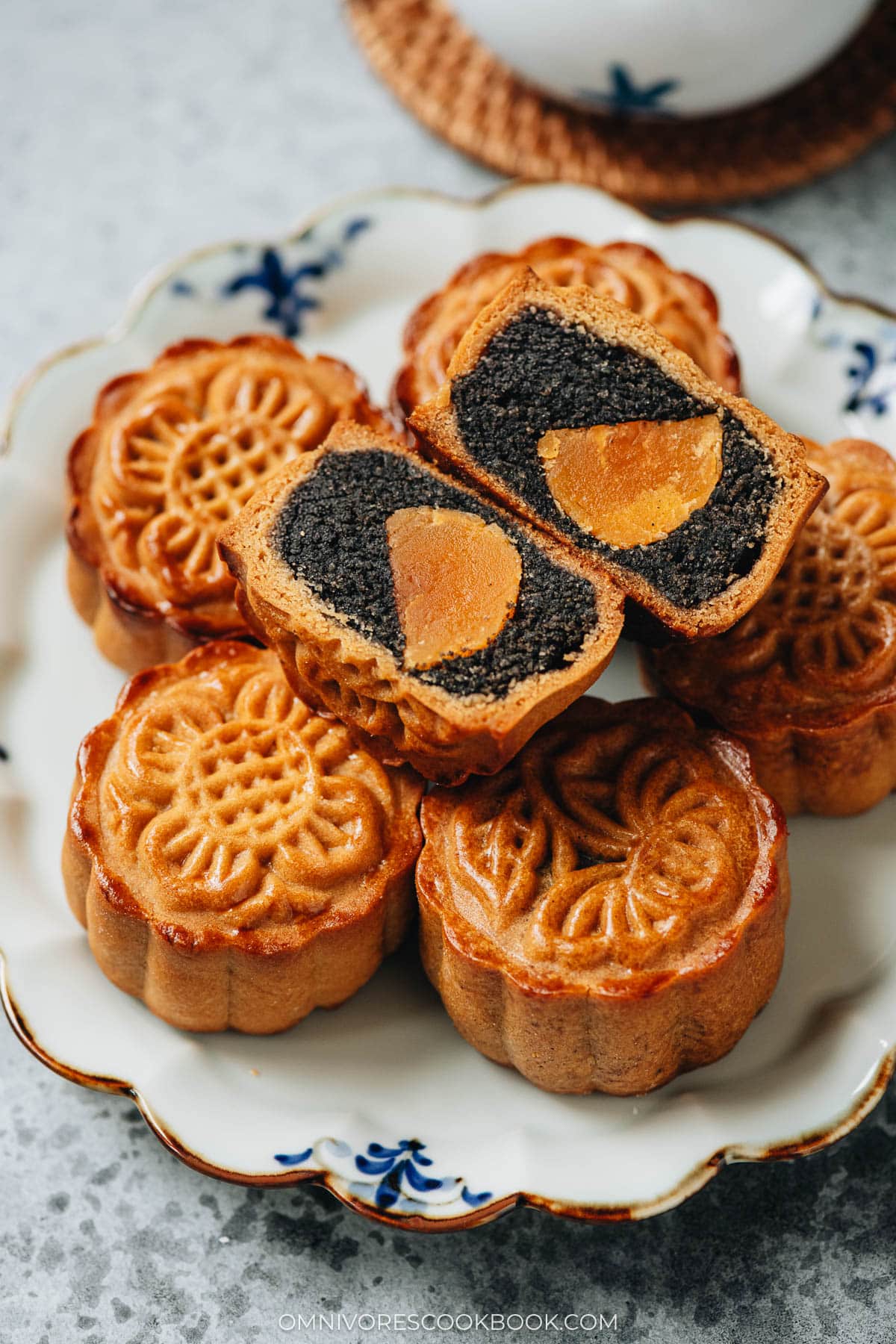
Special tools you need
To make the intricate mooncake patterns, you will need to purchase mooncake molds. There are traditional wooden molds available, but most home cooks prefer the plastic type because they’re easier to use.
Mooncake molds usually come in 50-gram and 100-gram sizes, with the number indicating the weight of the mooncake made by it. Most homemade recipes (including this one) work better with the 50-gram mold. It makes mini sized mooncakes that are very cute in appearance and easier to serve and gift. Larger mooncakes are often cut into quarters or halves when served, because they’re quite rich and sweet.
You can easily find all kinds of mooncake molds on Amazon. Choose your favorite patterns, but make sure you get the hand-press type mold.
Mooncake dough ingredients

Traditional mooncakes do not require a lot of ingredients, but you will need to purchase a few specialty ingredients. Fortunately, it is getting easier and easier to purchase these specialty ingredients online. And I’ve also included detailed posts on how to make the specialty ingredients at home.
Golden syrup
Also called inverted sugar. It attracts and retains moisture. This keeps the pastry tender, prevents crystallization, and helps the crust stay soft after the “resting” period (回油, hui you). It has a deep, caramel-like taste. It also gives the dough flexibility and just the right stickiness, so it molds cleanly and holds the intricate mooncake patterns after pressing.
In short, golden syrup provides flavor, color, moisture, and workability. They are all crucial for achieving authentic mooncakes.
You can purchase golden syrup on Amazon.
If golden syrup is not available where you live, you can also use my homemade golden syrup recipe to make it at home.
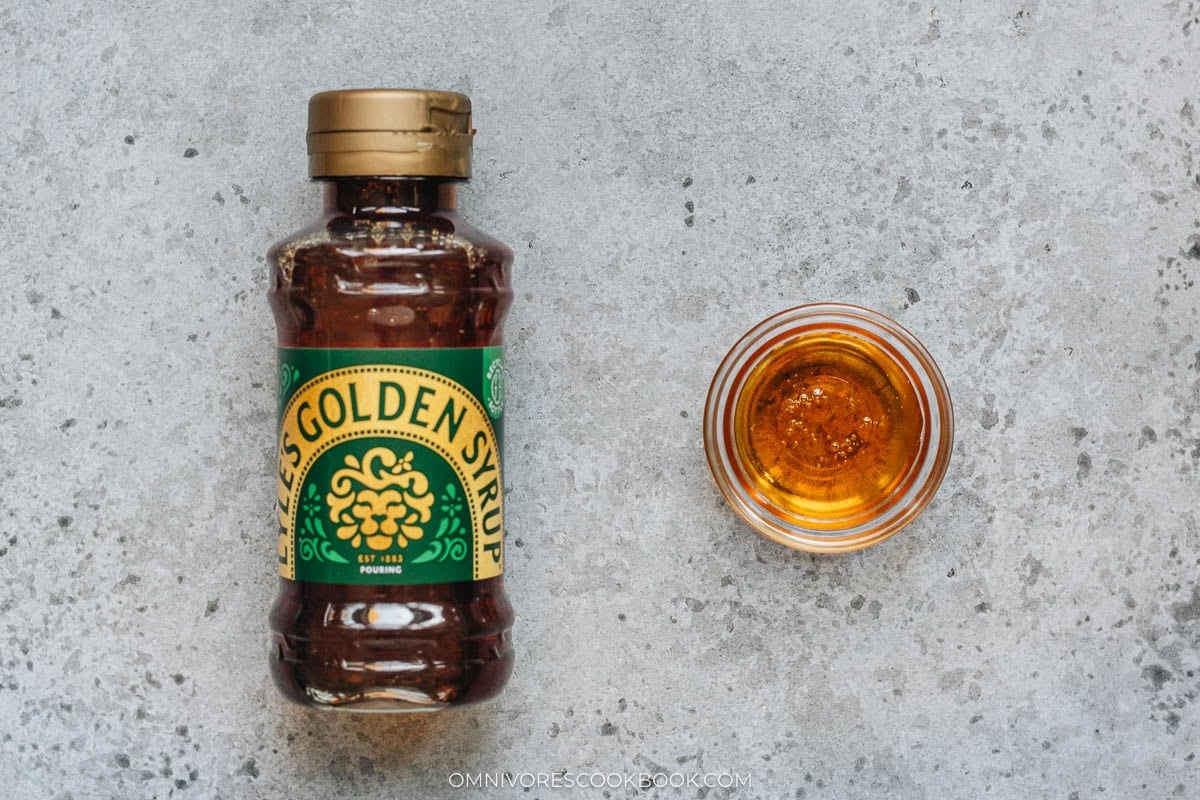
Kasui
Kansui (alkaline water, lye water, 枧水) works hand-in-hand with golden syrup in mooncake dough. Since golden syrup is slightly acidic, a small amount of kansui neutralizes that acidity, preventing the dough from being too sticky or weak. It also strengthens the gluten bonds just enough so the dough is pliable but not tough. This allows the dough to be very thin without cracking. Lastly, it helps the pastry absorb oil from the filling more evenly during the resting period, giving the skin that glossy, tender finish.
You can usually find kansui in Chinese markets, some large Asian markets such as Ranch 99, and at Chinatown shops. You can find it on Amazon as well.
If not available, you can use my homemade kansui guide to make it using baking soda.
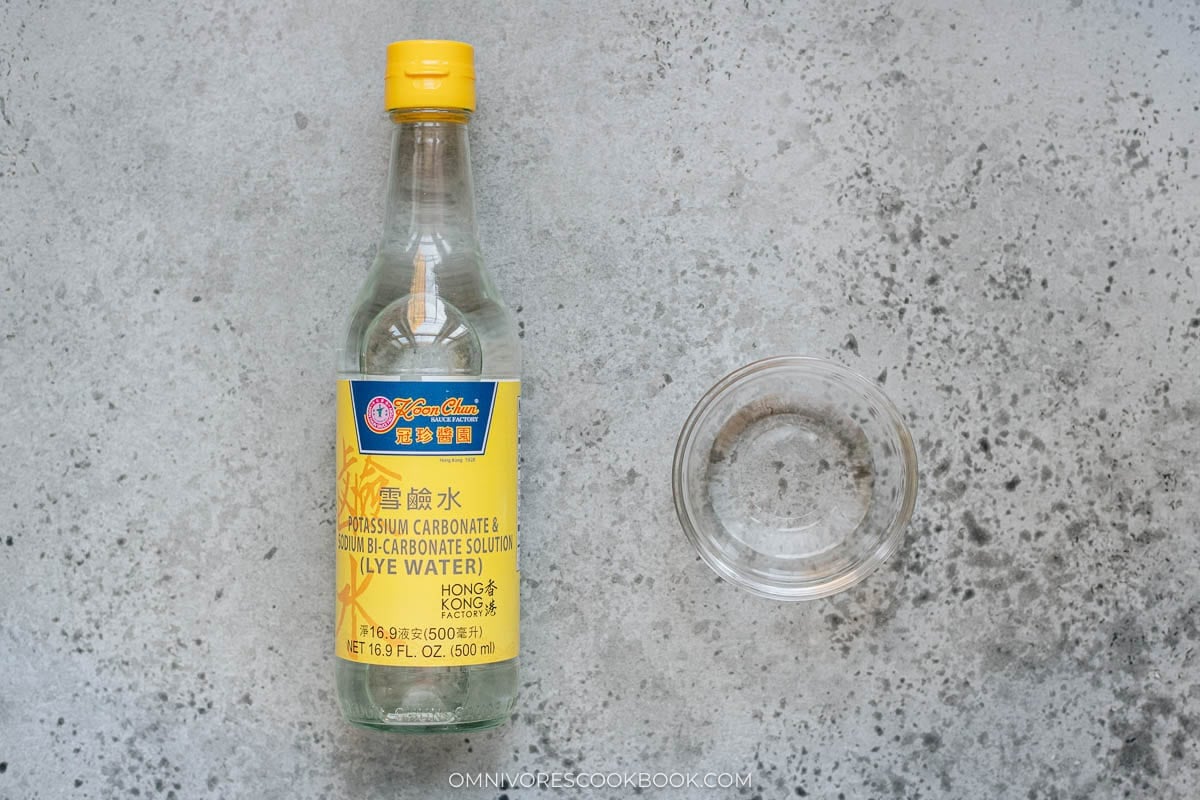
Cake flour
Cake flour is another key ingredient to create the tender mooncake dough texture.
Mooncakes in China are usually made with all-purpose flour. Compared to the fortified flour in the US, Chinese flour is milled differently and finer in texture. It is not fortified and has a lower gluten content (about 2%). In the US, the closest type is cake flour. It is essential to create a tender and pliable dough.
If you’re close to a Chinese market or large Asian markets, another great alternative is to buy Chinese all-purpose flour or Korean all-purpose flour. Both yield a slightly better texture than US-made cake flour.
That being said, it is possible to use all-purpose flour. Your dough might come out a little tougher, but I’ve included tips on how to work with tougher dough in the recipe below.
Mooncake filling ingredients
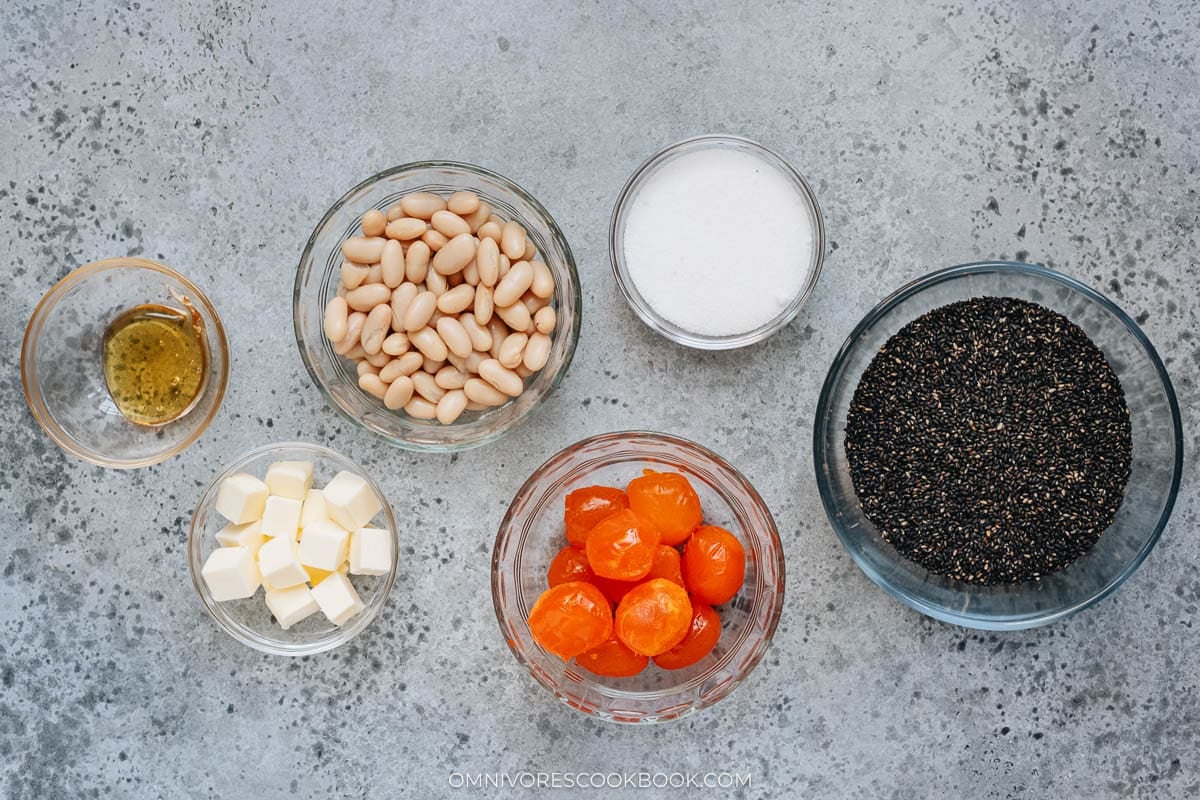
Black sesame paste is my favorite mooncake filling and I spent a lot of time developing the best texture. Here are some of the key ingredients besides black sesame seeds.
White beans
Most black sesame mooncake filling is not made of 100% black sesame seeds. Because 1) black sesame seeds are expensive. 2) Black sesame seeds alone do not yield the signature smooth texture that every mooncake filling should have.
In this recipe, I used white beans due to their very mild flavor and tender texture. They work as a binder so the filling is shapable. Due to their mild taste, the black sesame seeds blend right in and the filling won’t taste beany at all.
Butter
Traditionally, mooncake makers preferred to use lard in their filling, because it solidifies at room temperature and it makes the mooncakes easy to shape. In modern days, most people prefer to use vegetable oil.
In my recipe, I chose butter over vegetable oil because: 1) It adds a richer aroma to the filling and 2) butter solidifies in the fridge, making the filling easier to shape.
Maltose
Maltose (麦芽糖) is often used in traditional mooncake fillings. It is a very sticky and thick syrup at room temperature. It binds the paste together, making it smooth, glossy, and cohesive rather than crumbly. You can find maltose in Chinese markets and on Amazon.
That being said, I’ve made black sesame filling without maltose and the result was quite nice. If you do not have this ingredient, simply skip it and your mooncakes will turn out nicely.
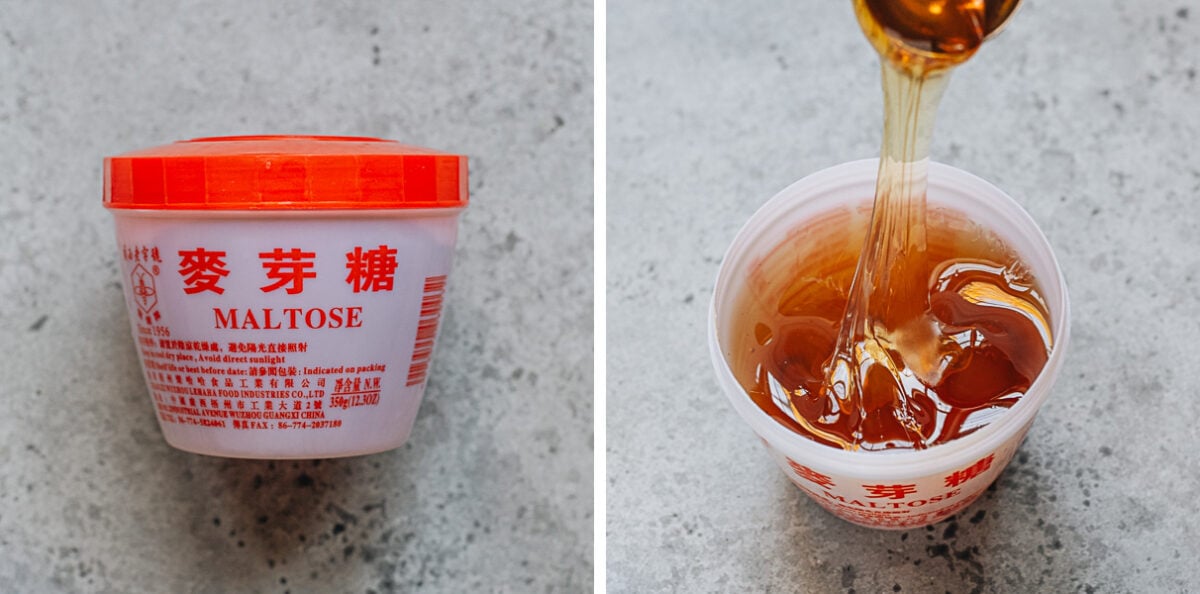
Salted duck yolk
Salted duck yolk is a classic element in Cantonese mooncakes and it’s my favorite thing about them. The rich, salty yolk balances the sweet, dense filling, making the mooncakes more complex and preventing them from tasting overly sweet. Salted yolks have a sandy, crumbly texture that contrasts beautifully with the smooth filling.
You can usually find frozen cooked duck egg yolks at Chinese markets. It’s also possible to purchase whole salted duck eggs and use only the yolks, but the packaged frozen type is much more convenient.
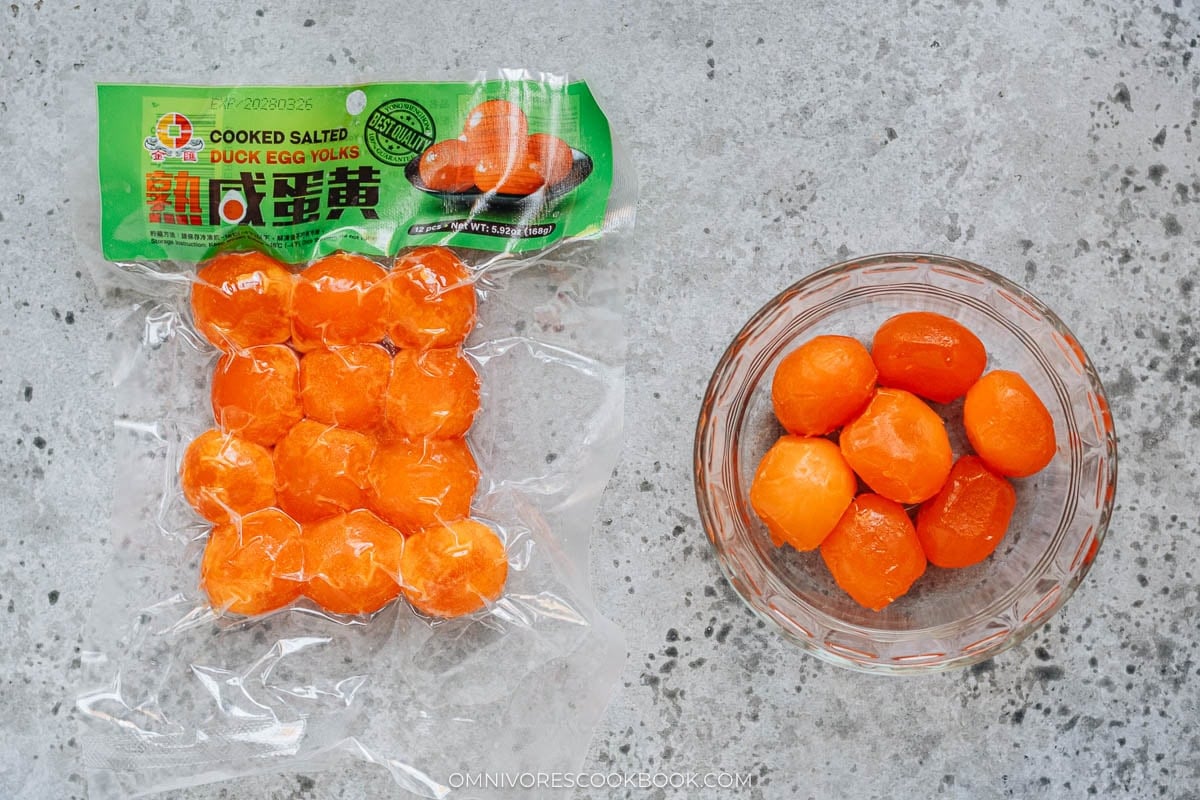
On the other hand, if you do not like this ingredient, it’s totally OK to skip it as well. In this case, you will need to make extra black sesame filling (see more details in the recipe below).
Why cut the duck egg yolk in half?
This recipe makes 50-gram mooncakes, which require 30 grams of filling. A whole duck egg yolk usually weighs around 14g and is very large in size. It’s very difficult to wrap a whole yolk into a small mooncake. It’s only possible to use whole yolks if you happen to find yolks that are smaller than 10g each, which are rare. That’s why I prefer to halve the yolks to make the shaping process easier.
Other filling alternatives
If you do not want to make black sesame paste filling, you have a few other options.
You can use store-bought mooncake filling. And the most common types are red bean paste and lotus seed paste. When shopping for red bean paste, make sure to check the ingredients – it should contain oil and maltose. This is the correct type for making mooncakes. Red bean paste made with water but not oil is not suitable for mooncakes.
If you have extra time, consider making these fillings at home. I have recipes for lotus seed paste filling and red bean paste filling. Compared to the store bought type, homemade paste has a richer taste and is more fragrant. You can also adjust the sweetness level to suit your own taste.

How to make
Traditional mooncakes require some time and effort to make. But if you’re organized and not rushed, it’s a very relaxing and enjoyable process. Make sure you have half a day and put on your favorite music or TV show!
Prepare the mooncake filling
My homemade black sesame filling has a fluffier and softer texture than the store bought type. But it requires a little more chill time so it’s easier to work with.
- Blend the black sesame seeds until they start to seep oil. This ensures a smooth filling without tasting gritty. I like to use toasted black sesame seeds because they’re easier to work with and yield a better result. If using raw sesame seeds, you have to roast them until they are cooked through beforehand.
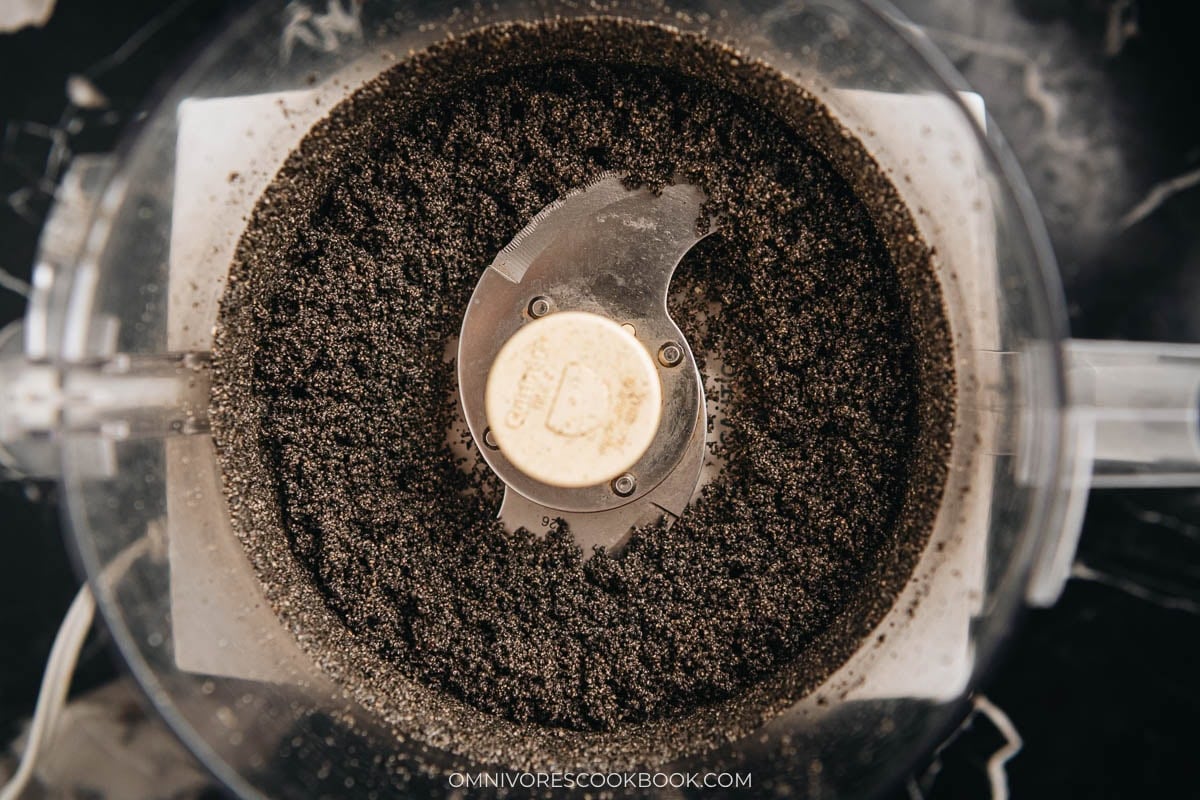
- Add the sugar and white beans and blend until it forms a paste. The paste is quite thick and your food processor might stop before everything is fully blended. You can add a little water in this case. If you add water, you will need to spend more time cooking off the water later, so the paste is dry enough to shape.
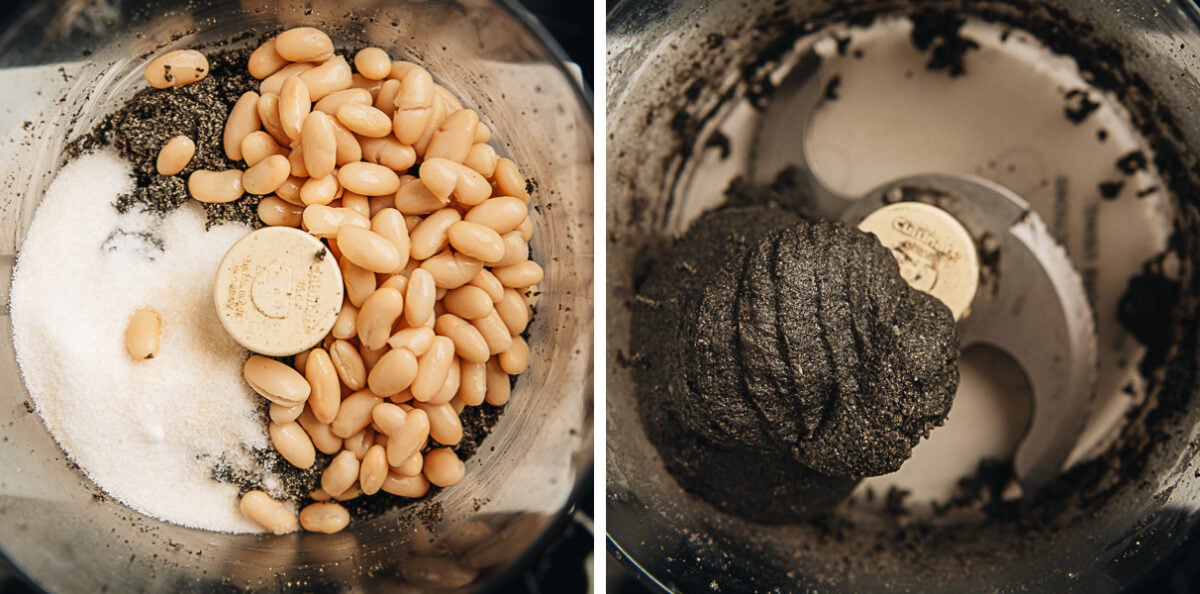
- Melt the butter and cook the butter into the paste. Then fold in the maltose, if using. The paste should look quite dry once cooked. And it will solidify further once cooled off. It is important to cook the paste enough until it’s quite dry. Otherwise the mooncakes will be very difficult to shape.

Prepare the mooncake dough
Mooncake dough is quite easy to put together. The most important thing is to measure out the ingredients in grams, so the dough has the correct texture.
- Mix golden syrup, kansui, oil and salt together. Stir them very well until the mixture emulsifies. This step is crucial. You want the golden syrup and kansui to react, so the dough forms properly.
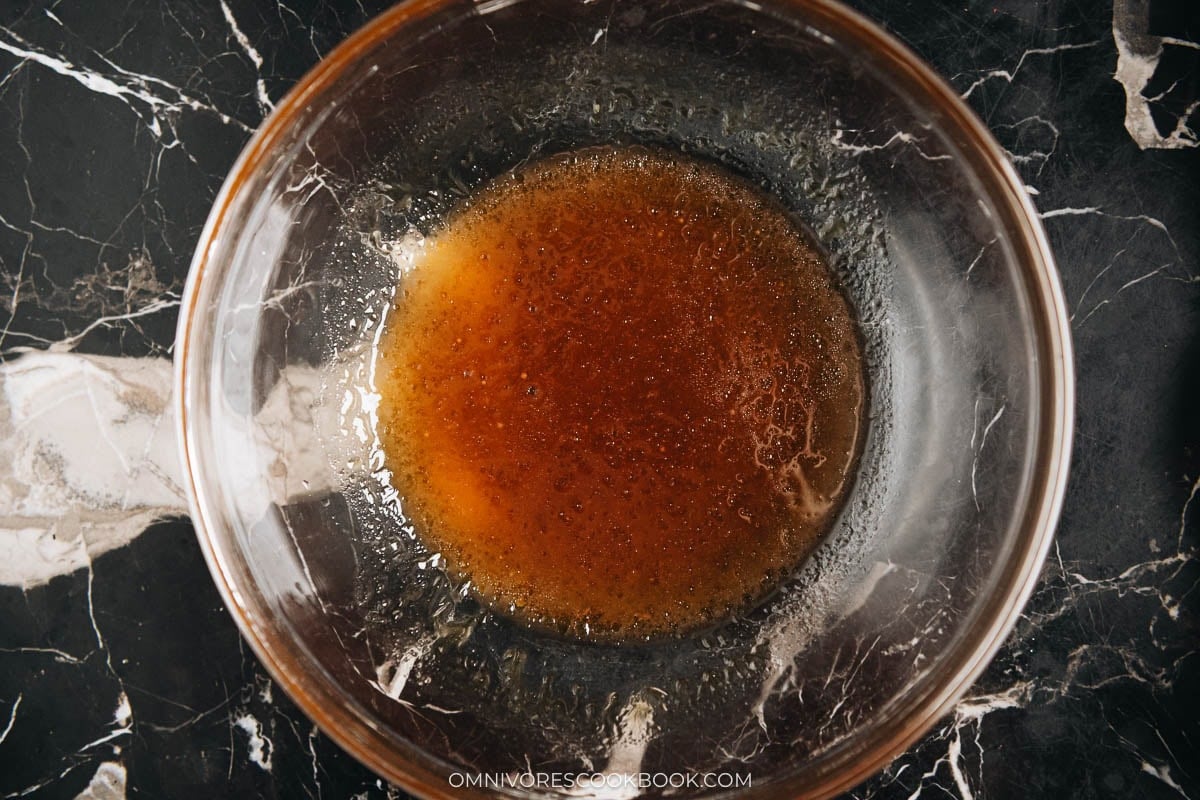
- Add the flour and shape the dough. Always using a scraping and folding motion, to avoid development of too much gluten. The dough will be quite soft and sticky, but should still hold its own shape.
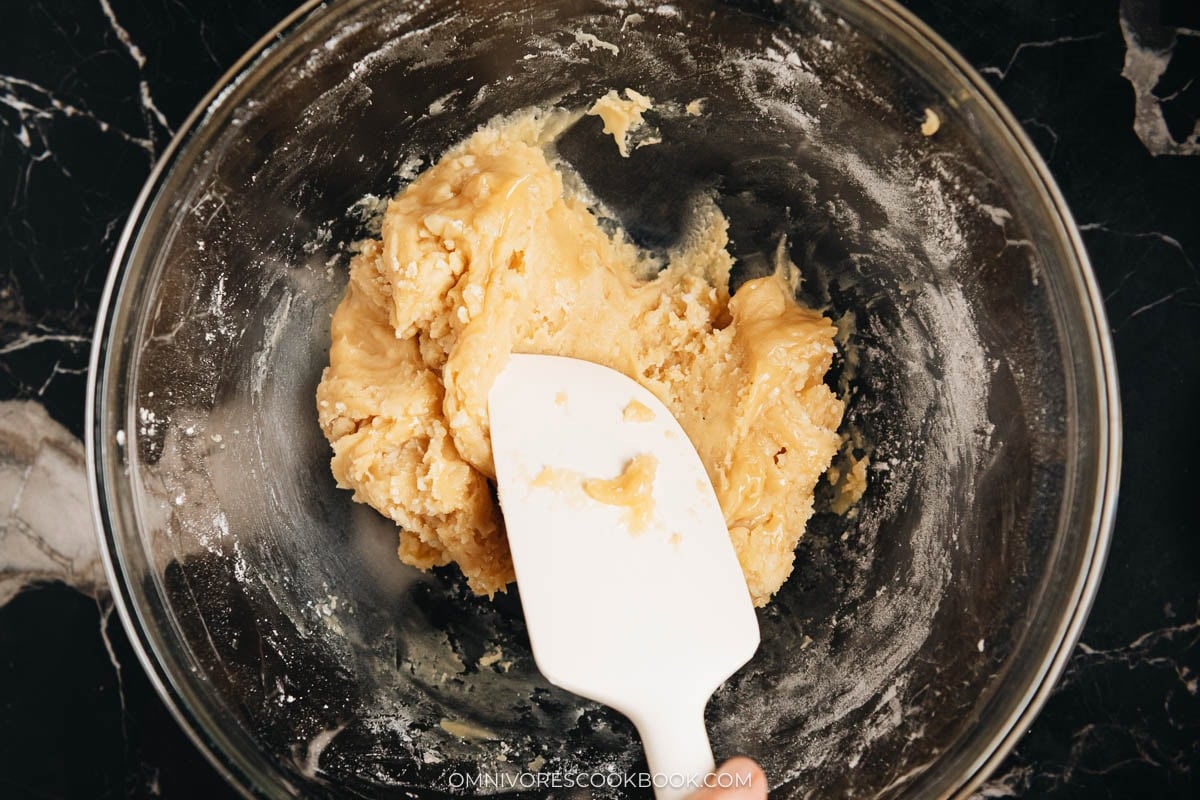
- Once the ingredients are fully incorporated, shape and gently work the dough with your hands until it forms a ball. Rest the dough for at least two hours, up to half a day. Do not refrigerate the dough.

Prepare the mooncake filling
- Measure out 30 grams of filling using a scale. It should be 30 grams in total if using both salted duck egg and black sesame paste. If you do not plan to use duck egg yolks, you should measure 30 grams of black sesame paste.
- Shape each filling into a ball. If using the egg yolk, wrap the yolk inside of the sesame paste then shape it into a ball.
- Store the shaped filling in the freezer for 30 minutes while you prepare the mooncake dough. This process further solidifies the filling, making it much easier to work with during shaping.

To assemble the mooncakes
- Once the mooncake dough is rested, divide the dough into 20-gram pieces and shape them into balls.
- To wrap a mooncake, press the dough piece in your palm so it’s thin in the center and thicker on the edges. Place the filling in the center. Slowly spread the dough over the filling so it covers the filling entirely. The mooncake dough should be soft and very pliable, with very few cracks during wrapping. If your dough turns out tough and hard to work with your hands, you can also roll out the dough using a rolling pin. In this case, sandwich the dough between two pieces of parchment paper to prevent it from sticking.

- You want to assemble all the mooncakes before moving to the next step. Cover the assembled but not shaped mooncakes with plastic wrap to prevent them from drying out.

- Once wrapped, dust the dough surface with a thin layer of flour. Place the dough ball into the mooncake mold. Then press the mold to shape the pattern. This step might require a little trial and error. You want to press quite hard, until there’s no room to move. If you notice dough starting to seep out from the mold, you’re pressing too hard. Once you’ve pressed down, you want to hold and press the mold for at least 5 seconds. This is key to ensure the pattern stamps properly and does not bounce back later.
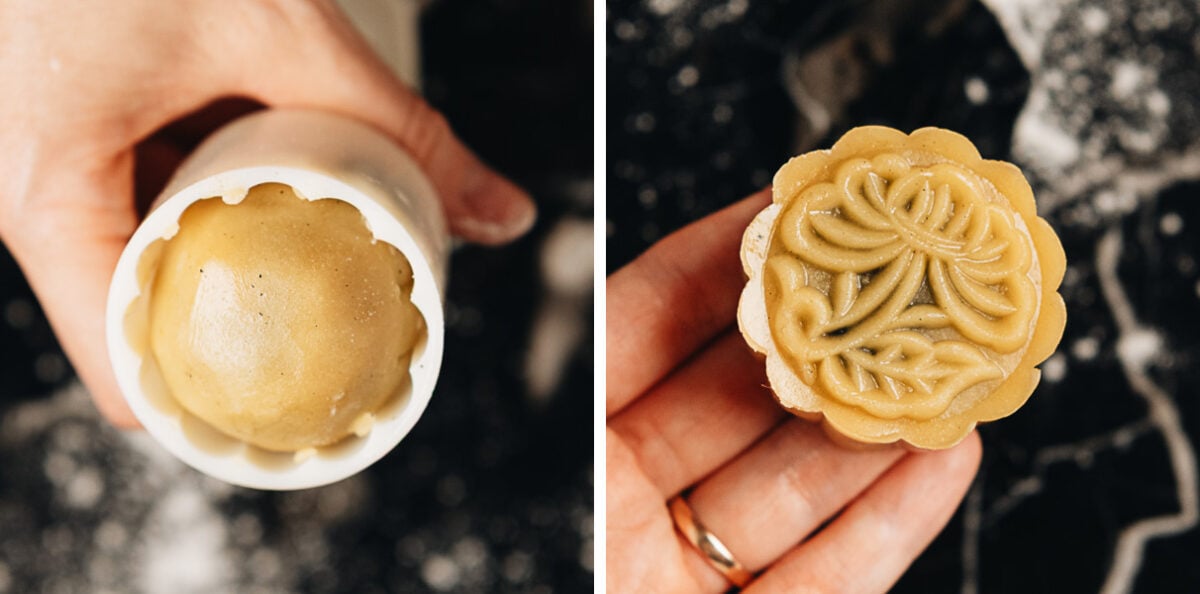
- Place the mooncakes onto a parchment-lined baking sheet. Once the patterns are stamped, you want to bake them as soon as possible to prevent the dough from drying out. If you’re working very slowly, you will need to cover the shaped mooncake with plastic wrap. But be careful not to press the wrap onto the mooncake, which might mess up the pattern.

Bake the mooncakes
- Bake at 400°F (200°C) for 5 minutes, so the dough is firm enough for the egg wash. Brush a very thin layer of egg wash onto the arched patterns and try to avoid the caved area. So only the arched area will become darker, giving the mooncake a more three-dimensional look.
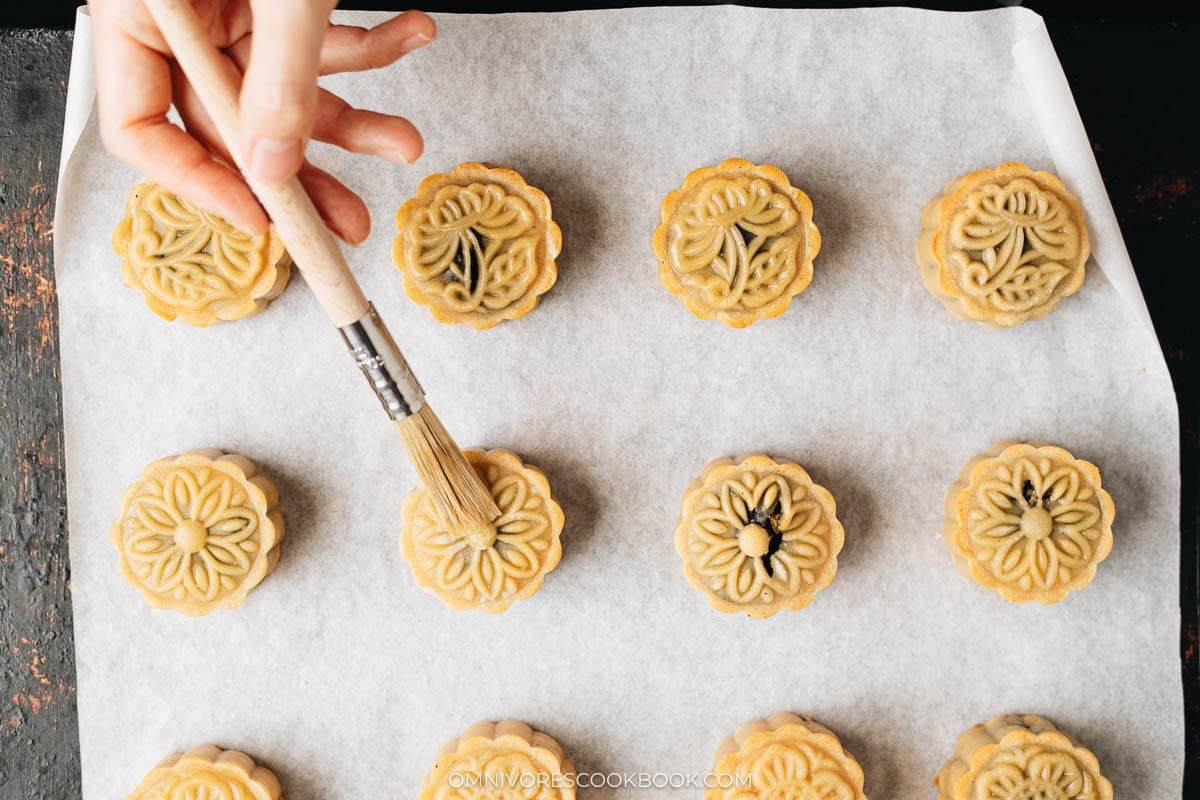
- Lower the oven temperature to 350°F (176°C) and bake for another 12 to 15 minutes, until the mooncakes turn golden brown. Once baked, the mooncakes will look a little dry and the colors uneven. But rest assured, they will look shinier and more even once rested for a day or two.
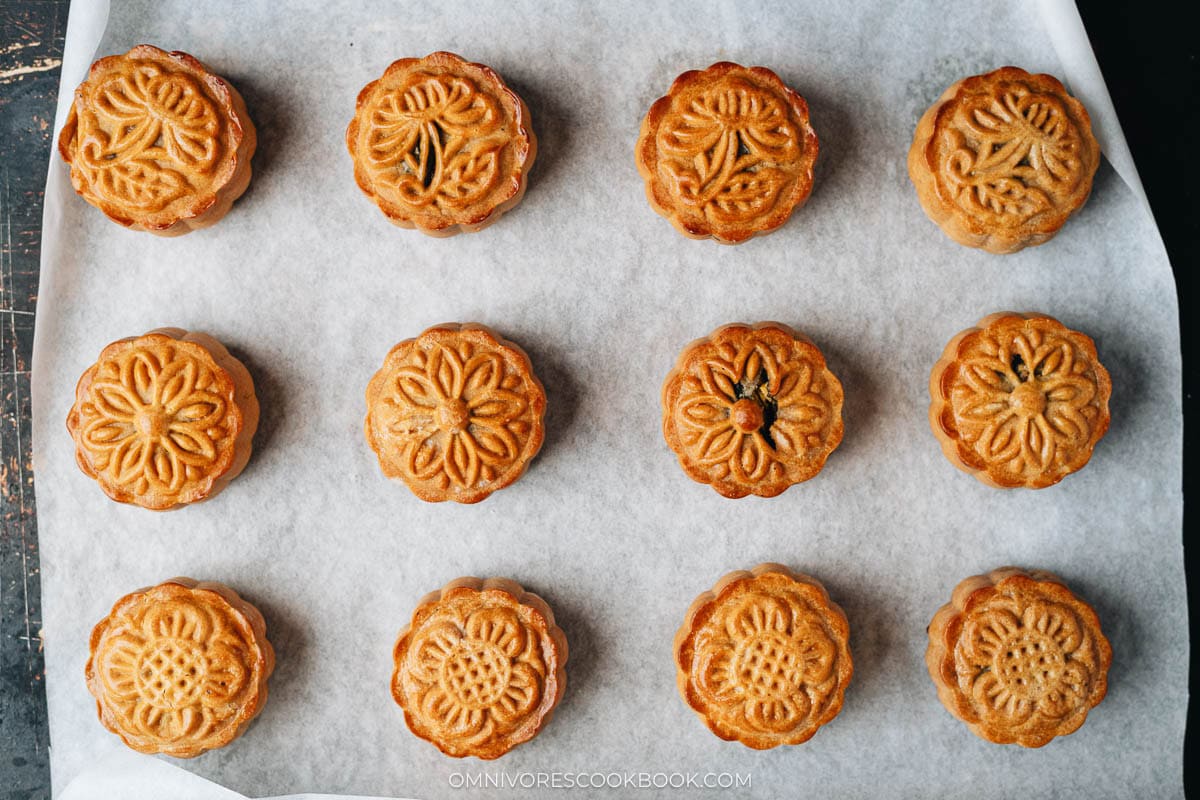
Why is resting mooncakes important?
Resting mooncakes after baking is one of the most important steps for achieving the right taste and texture. This process is called “回油” (huí yóu, “returning oil”), which means to wait for the oil to come out.
Freshly baked mooncakes have a dry, crumbly, and almost cookie-like crust. Resting allows the oil in the dough to migrate outward and the moisture from the filling to move inward, softening the skin into the signature tender, shiny layer. Over a few days, the skin darkens and becomes more golden and glossy, giving the mooncakes a professional look.
The rest period helps the filling and skin meld together. Sweetness, saltiness (from the salted yolk, if used), and aroma become more harmonious, rather than tasting separate.
Typically, Cantonese mooncakes need 2 to 3 days of resting before they’re ready to enjoy at their best. But they usually start to look and taste much better after resting overnight. I always taste them the next day, because I have no patience to wait two days 🙂
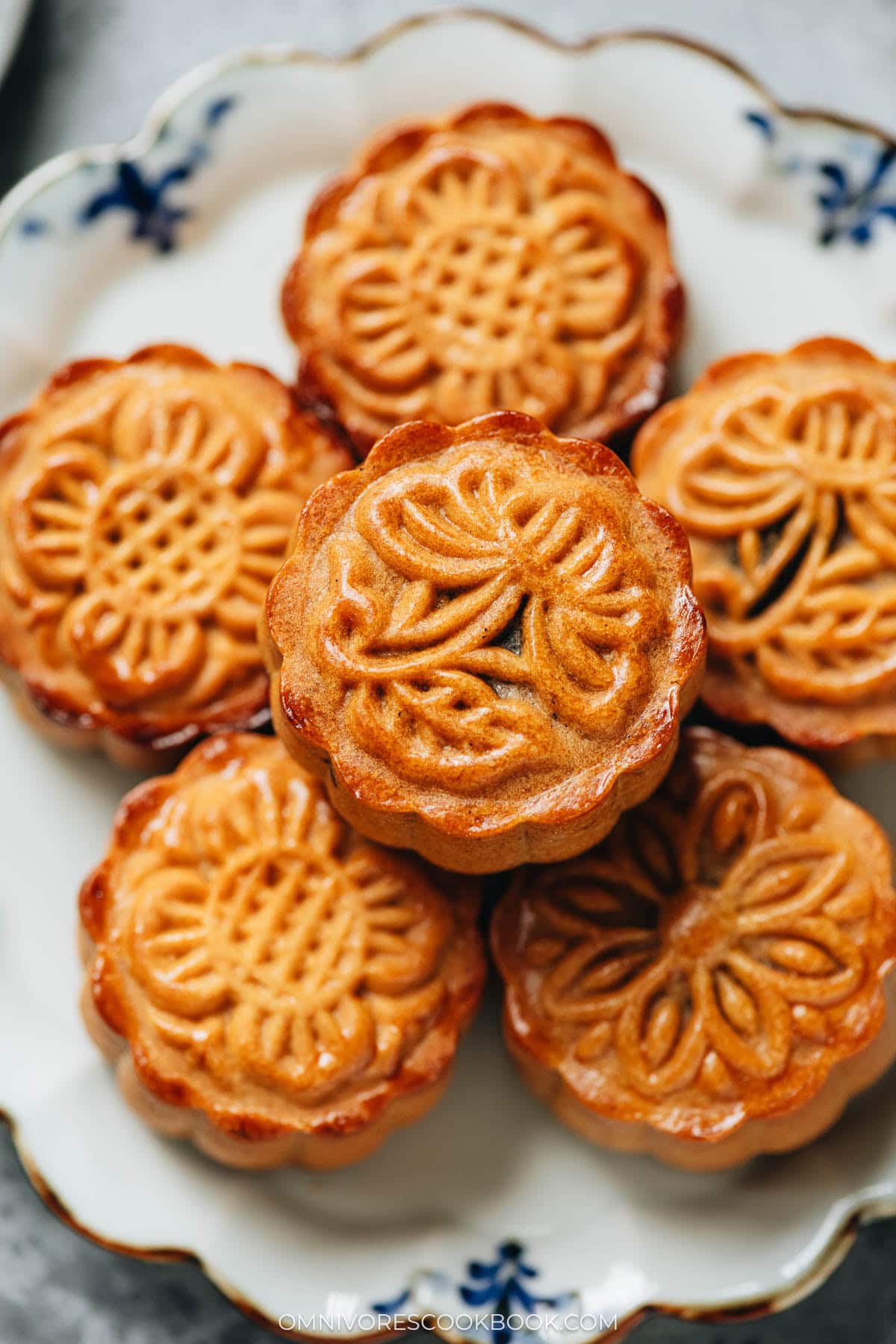
Cooking tips
A scale is the key to success
Making mooncakes requires precision. For the right texture, you will need the correct ratio of flour to golden syrup to kansui. You want to measure the filling quantity so the mooncake has an appropriate proportion of dough to filling. Volumetric measurement and eyeballing simply will not cut it for this recipe.
Be flexible on temperature and baking time
Different ovens will vary in their temperature consistency. I’ve baked mooncakes at 400°F (200°C) and 350°F (176°C), both with good results. I found it best to bake first at a higher temperature for the dough to set, so I can brush the egg wash on easily. Then reduce to a lower temperature to bake evenly and further develop the color. Keep an eye on the mooncakes while baking. If the mooncakes start to develop color too quickly, you might want to reduce the baking time. If the mooncake does not develop color towards the end of cooking, consider raising the temperature back to 400°F (200°C).
Serving and storage
Let the mooncakes rest for 24 to 72 hours after baking. Flavor and texture improve with time.
Store in an airtight container at room temperature if possible, and eat them within a week. Refrigeration can alter their texture.
If freezing, wrap them well and store them in the freezer for up to two months. Thaw them in the fridge slowly, and let the mooncakes return to room temperature before serving.
Frequently asked questions
Do I need to cook the salted egg yolks separately first?
If the salted duck egg yolks you bought are the cooked type, then you don’t need to cook them first. If using raw yolks, you will need to bake them at 350°F (176°C) for 8 to 10 minutes to cook them through before using. Some recipes suggest baking cooked yolks to get rid of the gaminess, but I found that unnecessary.
Can I make the black sesame paste filling in advance and freeze it?
Yes you can! It’s best to freeze the sesame filling after you shape it into balls. So you can directly wrap the mooncakes without thawing the filling. It works beautifully because frozen filling is much easier to work with. If the sesame filling is very frozen (unlike the 30-minute freeze in this recipe), you might want the assembled mooncakes to thaw a little bit before putting them into the mold and shaping them.
Why did my mooncakes crack during baking?
It’s a common practice to spray water onto the mooncakes before baking, to prevent them from cracking. Cracking happens when the dough is not elastic enough. It might happen if you don’t use enough liquid, the flour contains too much gluten, or if the mooncakes are left out too long before baking. Another cause can be because the filling is too wet – especially if you try to make the filling with other ingredients such as sweet potato.
Can I use another type of oil instead of vegetable oil?
Peanut oil works well because it adds nuttiness that works with black sesame filling. Other neutral oil such as sunflower oil will work too.
Can I make mooncakes with chicken eggs?
Yes you can! You can cure chicken egg yolks with salt and sugar. Once cured, the yolks will solidify and can be used in this recipe. Chicken egg yolks are also smaller, so you might be able to fit one yolk into a mooncake instead of halving it, if the yolk is under 10 grams.
Do I have to wait 24 hours to eat these? Or is it possible to eat them straight away?
You can eat them straight away, but you might be disappointed with the texture. The mooncake skin will be rather tough and crumbly, and a little dry. Just so you know, I always taste one straight away because I can’t wait. But the mooncakes start to taste noticeably better on the third day.
Final thoughts
Traditional Cantonese mooncakes are exquisite when done right, not just for their ornate appearance, but also for the harmony of sweet, salty and savory umami. It will take a little practice and patience to make them nicely, but the result is definitely rewarding. Even with boxes of them for sale everywhere this season, homemade mooncakes offer qualities often lost in commercial production. You can taste the freshness of the ingredients and notice a much better depth of flavor. I also like homemade mooncakes because they are less sweet and not as heavy as the commercial type. Lastly, an edible gift made with your own hands is always more special.
If you’re interested in learning about other types of mooncakes, check out my Snow Skin Mooncake with Custard Filling and Pastry Mooncake with Salty Egg Yolk.
Happy Mid-Autumn Festival and I hope you enjoy these homemade mooncakes!
Chinese Cooking Made Easy
Are you new to this website? This free email series is a great place to start. I’ll walk you through a few of my most popular recipes and show you how and why they work. You’ll quickly start to cook better Chinese food in your own kitchen.
Watch video
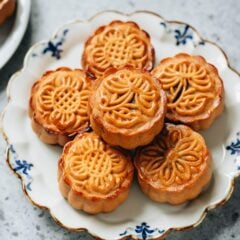
Traditional Mooncake (传统广式月饼)
Ingredients
Mooncake filling
- 140 g (1 1/3 cups) black sesame seeds , toasted
- 80 g (2/3 cup) fine white sugar
- 60 g (4 tablespoons) butter
- 150 g (1 cup) white beans , well drained
- 1 tablespoon maltose (Optional)
- 9 salted duck egg yolks , halved (*footnote 1)
Mooncake dough
- 140 g golden syrup
- 4 g (3/8 teaspoon) kansui
- 50 g vegetable oil
- 1/8 teaspoon salt
- 200 g cake flour
Egg wash
- 1 egg yolk
- 1 teaspoons milk (or water)
Equipment
- 50g mooncake mold
- Scale (*Footnote 2)
- Pastry brush
Instructions
To make mooncake filling
- Add the black sesame seeds into a food processor. Blend until the sesame seeds start to seep oil and thicken, about 2 minutes. Use a spatula to thoroughly scrape the paste from the walls and bottom of the food processor. Blend again until it forms a fine paste, 1 to 2 minutes. Scrape the paste from the walls and bottom.
- Add sugar and white beans. Blend again until everything is fully mixed. If the paste is too thick to blend, you can add a very small amount of water. Transfer the paste to a bowl.
- Heat half of the butter in a medium-sized skillet over medium heat until melted. Add the bean paste. Cook and stir until the butter is fully absorbed. Add the rest of the butter and cook until fully absorbed. Add the maltose if using. Cook and stir until the paste becomes quite dry and able to hold its own shape, 3 to 4 minutes. Transfer the sesame paste to a plate and spread it out. Let cool completely. You can store the sesame paste in the fridge to make it easier to handle later.
To make mooncake dough
- Combine golden syrup, kansui, vegetable oil and salt in a large bowl. Mix with a spatula until emulsified.
- Add cake flour into the bowl. Gently fold the dough with a motion of scraping from bottom to top, like you are folding a cake dough. Do not stir the dough in a circular motion. It will toughen the dough.
- When the flour is fully combined, shape the dough into a ball with your hands. The dough should be soft and a bit sticky but still hold its shape. Seal with plastic wrap. Let rest for 2 hours.
Measure the mooncake filling and dough
- Once it has cooled off, divide the sesame paste into 30-gram portions if not using duck egg yolks. Or add half a duck egg yolk and some sesame paste onto a scale, so that it weighs 30 grams in total. Shape the sesame paste into a ball, then press the center to form a disk. Place the egg yolk in the center. Wrap the sesame paste around the yolk until fully covered, then shape it into a small ball. Place it onto a tray,
- Once you have shaped all the mooncake fillings, cover them with plastic wrap and place them in the freezer. Wait until the balls harden so they’re easier to handle, 30 minutes or so. (*Footnote 3)
- Once the mooncake dough is rested, scoop and measure 20g dough pieces. Shape each dough piece into a ball using your hands. Then place them onto a large tray. Cover the tray with plastic wrap to prevent the dough from drying out.
To assemble mooncakes
- Preheat oven to 400°F (200°C). Line a baking sheet with parchment.
- Place a dough piece onto your palm and use your thumb to flatten the dough from the center, until it forms a round disk that is thinner in the center and thicker on the outside. Place the black sesame filling in the center. Carefully wrap the dough around the filling. Spread the dough until it seals the filling in completely. The dough should be very soft but not sticky, and easy to shape, like soft clay. (*Footnote 4) If you find the dough too thick in some spots, pull off the dough and smooth the surface. It doesn’t matter if the dough is so thin that it reveals the color of the filling. Roll the dough between your hands until the dough forms a smooth ball.
- Slide the plastic pattern disc into the mooncake mold, pattern side down. Twist the handle to lock the pattern disc so it’s secure.
- Dust both hands and the mooncake dough with a bit of cake flour, so it’s easy to release from the mold. Carefully place the mooncake into the mold.
- Place the mold on a clean working surface and firmly press the handle until you cannot move it any further. Hold the handle down for at least 5 seconds so the pattern sticks. Then release the mold from the table and push the handle to release the mooncake onto the lined baking sheet. Work on the rest of the mooncakes and place them onto the tray, about 1” (1.5 cm) apart. Spray a very small amount of water onto the mooncakes to prevent the dough from cracking. Bake for 5 minutes until the patterns are set. The edges of the mooncakes should turn pale golden.
- Meanwhile, make the egg wash by beating the egg yolk with milk (or water) in a small bowl.
- Remove the mooncakes from the oven. Brush a thin layer of egg wash onto the surface of the mooncakes. Only brush the top surfaces, not the vertical (side) surfaces. Try to only brush it onto the arched pattern, and not the recessed concave area. If you accidentally brush too much egg wash and it fills in the pattern, use a small brush to clean the gaps and remove the excess egg wash.
- Place the mooncakes back in the oven and lower the oven temperature to 350°F (176°C). Continue baking until the egg wash turns golden brown, 12 to 15 minutes.
- Let mooncakes cool on the tray for 20 minutes before removing (*footnote 5). Then transfer to a plate to cool completely.
- Once cooled completely, store the mooncakes in an airtight container. The mooncakes can be served after 24 hours, and they will look and taste better after 2 days. (Footnote 6)
Store
- Store the mooncakes in an airtight container in a cool dark area for up to 1 week, or in the fridge for 2 to 3 weeks, or in the freezer for up to 2 months. If stored in the fridge, let the mooncakes return to room temperature before serving. Thaw frozen mooncakes in the fridge overnight before serving.
Notes
- To make black sesame mooncakes without egg yolk, double the black sesame filling and you will be able to make 18 mini mooncakes.
- Mooncake making requires precision and you have to use a food scale to measure the ingredients. Using volumetric measurement won’t be accurate enough and your mooncakes might not come out nicely if you go by volume.
- Sesame filling is not as sticky as other mooncake fillings, such as lotus seed and red bean paste. That’s why I prefer to chill the filling in the freezer before wrapping, so the filling hardens up.
- If your dough turns out too tough to shape with your hands (usually happens if you use all-purpose flour, which contains more gluten and makes a tougher dough), you can do this instead: Place the dough between two pieces of parchment. Press it into a flat disc. Roll it into a small round sheet. It should be fairly easy to wrap the dough using the dough sheet. If the dough sheet breaks off, you can easily patch it onto the filling until the filling is fully covered.
- The mooncakes will be flaky and soft when hot. If you remove them right after baking, the cakes will crush easily.
- The process is called 回油 (Hui You), a process whereby the oil from the filling releases into the dough, making the mooncake dough softer. The mooncake will look a little dry immediately after baking, but will look moist and tender after a day or two. The patterns will also have a rounder, nicer look.
Nutrition

Did you make this recipe?
I’d love to hear how it turned out for you! Please take a moment to leave a 5-star rating ⭐️ and share your thoughts in the comments further down the page. It really helps others discover the recipe too.
This recipe was originally published in September 2015 and was updated in September 2025 (wow it has been 10 years!). In the updated version, I did a few things differently:
- I used commercial golden syrup and kansui instead of the homemade type. Compared to 10 years ago, both ingredients are more available and it’s easy to purchase them online. I recommend using the commercial type instead of homemade, if possible. Because the acid level in the syrup and alkaline level in the lye water are not precise when you make them at home. Using the homemade versions might result in cracked mooncake dough.
- Instead of using glutinous rice flour, I used white beans in the filling as a binder. The beans improve the mooncake texture and make it smoother.
- The new recipe has a slightly improved dough texture that is easier to work with.
- I updated the shaping method and baking temperature, so the mooncakes look better.

Donna
Hi Maggie,
Thank you for the really ultimate guide to making mooncakes.
I just have 1 question regarding the golden syrup, can it be substitute by honey?
best regards,
Donna
Maggie
Hi Donna, I wouldn’t recommend to substitute golden syrup by honey. Golden syrup is a key ingredients that causes the “oil seeping” process and helps to make the mooncake skin tender, which makes the mooncake Cantonese style. If you plan to use honey, I recommend you to find another recipe that makes a different mooncake dough (it makes a thicker and flakier skin, instead of a thin and tender one like this recipe). You won’t need kansui either if you don’t use golden syrup.
Pauline
Yes you can use honey ive just followed amanda ,s mooncake and it turned out perfect like bought ones just spray a thin layer mist of water before baking at 160 c not 180 c
joy
Thank you so much for this super informative guide! I can really see that you put so much of your heart into this post Happy Mid-autumn festival!
Maggie
Glad to hear you like the post! You too, Happy Mid-autumn festival 🙂
KK Hong
Hi Maggie,
Very impressed with the technical points of this wonderful dessert.
Just a question. I love using pork lard for my cooking and I was wondering what would the substitution ratio be for the butter in the filling? I know it cannot be 1:1 because butter has a higher water content than lard, but Im not sure by how much? Do you know?
I also read about how the filling fat/oil component is supposed to seep out into the skin of the dough to make it moist. Does that mean I will need to mix my lard with a vegetable oil to make it more runny? And what temperature must the mooncakes be “matured” at? Im guessing it has to be relatively warm-ish. Its currently winter/spring in Australia so the ambient room temperature kind of low (20-25 degC)
As for the vege oil in the dough, can I also substitute that for lard? Im guessing that would not affect the dough too much and would even make it more chewy and creamy because of the higher fat content and higher melting point
Warm regards,
KK Hong
Maggie
Hi KK, I have trouble give you a specific answer because I never test the mooncake recipe with lard. But I imagine it shouldn’t be a big difference. If you use the same amount of fat to replace butter, you should get a filling that is slightly easier to work with. In fact, many Cantonese mooncake recipes do not even require using fat in the filling, if you’re using a more solid ingredients such as sweet bean paste. I needed to use a solid fat here, because the black sesame paste is quite runny and unable to shape.
About the “oil seeping process”, it is actually related to the oil and inverted sugar (golden syrup) ratio in the skin, not the filling. That’s why the mooncake skin always call for vegetable oil. Most of the Cantonese mooncake recipes call vegetable oil for the skin. I’ve seen other type of mooncake recipes call lard, but it will create a different type of texture (a thicker crumbly pie like texture).
If your ambient room temperature is a bit low, the mooncakes will take a bit longer time to mature. But it shouldn’t cause a problem.
Hope your cooking goes well and Happy Mid-autumn festival 🙂
KK Hong
Hi Maggie,
Sweet thanks for your advice! I see… I didnt know that the fat was used as a structural component as well. Good to know. Oh speaking of other fillings? Do you happen to have a recipe for other filling as well?
Okay looks like Ill stick to peanut oil for the skin. Dont want my mooncake skin to fall apart as I cut it open haha
Okay cool. Ill just keep it for longer before serving then
Thanks a million! Happy Mid Autumn Festival to you and your family too! 中秋節快樂!
Warm regards,
KK Hong
Maggie
I don’t have another mooncake filling now but I’ll be sure to create more! Didn’t realize it’s such a popular thing when I wrote about the mooncake topic. I guess because it’s just too easy to buy them in China and nobody makes them at home.
Happy cooking and Happy Mid Autumn Festival 🙂
Sara
Maggie, if it ever interests you, please post a recipe for lotus seed and red bean fillings!
This was such a great post. I can’t wait to make some and send them to my family.
Thank you, thank you!
Maggie
Hi Sara, I will definitely add it onto my to-cook list! I like lotus seed and red bean fillings too 🙂 Glad you like this recipe. Hope your cooking turns out great!
Kare
Excited to try this! Where can one find salty duck egg yolks? Chinese grocery story? And could you possibly provide the Chinese characters so that I can identify them? Thanks!
Maggie
Hi Kara, yes you can find salty duck egg yolks in Chinese grocery store or large Asian market. The Chinese characters are 咸蛋黄 or 鹹蛋黃.
They are mostly come in a transparent package that looks like this: http://www.hcfoods.net/assets/images/a-de-101-kp.jpg
So it shouldn’t be too difficult to locate.
Happy cooking 🙂
Kare
Thank you!
Jas
Maggie, the paste do not need to cook?
And may I know why some need to add egg yolk in the moon cake dough, and the purpose is? Thk u
Maggie
Hi Jas, you don’t need to pre-cook the paste. The filling and skin will be cooked together while baking.
To answer your question about adding egg into the dough, there are many types of mooncakes and they feature different texture. I talked about traditional Cantonese mooncake in the post, where people use a very thin mooncake skin with a large filling. Another type of mooncake (especially the ones in northern China) uses a thicker mooncake skin and it features a flaky dough that tastes more like biscuit. That type of dough might use egg yolk to create a different texture. There is no right or wrong. It’s all depends on your personal preference 🙂
Natalie
Thank you for sharing this recipe and all the details, I will try them this weekend as Mid-Autumn festival is less than 2 weeks away! 😉
Maggie
Good luck with the cooking Natalie! Let me know how these mooncakes turn out 🙂
Linda
Can you tell me how long the traditional mooncakes can keep? And what is the best way to keep them to maintain the excellent texture and flaver. I habe left thwm out in a sealed containeer up to3 weeks. Can thay keep a month? Can they be rrefrigerated or freezered. And still be as good?
Oni
Wow the effort and detail you have put in this is absolutely amazing. I’m so thankful I found your blog. Keep up the beautiful work. Bless you.
Maggie
Thanks Oni! I’m glad to hear you enjoy reading my blog!
Lokness @ The Missing Lokness
You go, girl! Congrats on finally making them right! They are absolutely perfect! I have never tried one with sesame filling. Lotus paste is the one I eat the most. But these sound delicious!
I know exactly how you feel about wanting to make mooncakes since you are away from home. Flavors from home are extra special even though some food may not be your favorites growing up. Having a bite of a mooncake and watching the moon is like connecting with families and friends that are far away. Hope you had a wonderful mid-autumn festival!
Kathleen | Hapa Nom Nom
Maggie. These…are… STUNNING! Seriously, like little works of art! I would have to sit and admire it before I ate it! And I love hearing the history and culture behind it.
Christine | Vermilion Roots
Thank you for such a lovely and extensive post about mooncake! Hope you are having a good celebration. 🙂
Marissa | Pinch and Swirl
You are simply amazing, Maggie – truly an inspiration. Your mooncakes turned out perfectly – I’ll have to gather the courage to try this recipe. 🙂
Tracey@Salty Sweet Life
Wow, Maggie, this is just incredible! You have gone above and beyond with this article and it is so well done! I celebrated mid-Autumn festival with my friend and her family last night as we have done for a few years now and the moon-cakes are my favorite things! I, too, love the salty egg yolk cakes best of all. Your moon cakes are absolutely beautiful–like works of art! Thank you for all your hard work in preparing them and teaching the method!
Monica
This is truly amazing! What a very serious labor of love. You should be very proud of yourself…such a very painstaking project but something to cheer with such amazing results in the end!
Gretchen
Maggie! You are a treasure. Your beautiful work and way with food is inspiring! You teach me so much, and always with encouragement and no judgement. This mooncake piece represents your commitment to sharing your culture with love and delightful care! Happy mid Autumn Festival to you and your loved ones! Thank you, sweet lady for all that you give!
Soe
Maggie, this is beautiful. You are so talented.
Whing
This recipe works every time and I refer to it each year. Just wanted to run out how long mooncakes last and can you freeze them
donna mikasa
I arrived here via Season With Spice and I’m blown away that you made mooncakes–especially since I just bought a box of four of them for my daughter’s in laws. I know they won’t be as good as yours and I’ll show this to my daughter. Maybe she’ll surprise her husband’s family next Mid Autumn!
Patty
HOLY COW, Maggie! I am floored at the lengths of technical experimentation to which you went for those stunning mooncakes. They are gorgeous, and they look really delicious. Thank you for putting so much into your quest to create the perfect mooncake. I think these may be my favorite food photos of yours to date.They may be my favorite food photos of ANYONE’S. Very impressive.
Susan
I doubt that I will ever make mooncakes, but I still find this an amazing post. I don’t know that many people would put as much effort into a post like this as you did. It was especially interesting learning about golden syrup and kansui.
One note on something you might want to correct: the picture showing mooncakes made with baking soda vs. kansui, the caption should read ‘the mooncake on the left used baking soda…’
Bam’s Kitchen
Oh my goodness this recipe is pure GOLD!!! Sesame is my absolute favorite kind of mooncake! All of your helpful tips and gorgeous photos are fabulous. Stunning moody photos are my favorite!!! I read the whole big post BTW… Sharing everywhere!!!! and smoke signals sent too. 中秋节快乐!
Meggan | Culinary Hill
Wow, Maggie! This is incredible! What a wealth of knowledge you learned, gathered, and shared with us all. I randomly have a can of golden syrup in my pantry that my in-laws brought home to me from England. Is this a sign that I should make these?!?! Who knows. But I sure enjoyed reading all 4000+ plus about the history and the process. I love that you made over 10 batches. I love that I can count on you for the very best. And, I’d say married life seems to be treating you rather well! Thanks again for sharing, and obviously I pinned this. 🙂